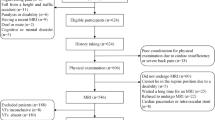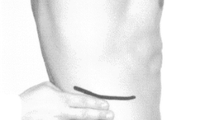Abstract
The aim of this study was to investigate associations between the location of osteoporotic vertebral fractures and the patient’s localization of pain. Fifty-one consecutive patients (m 6, f 45; average age 74.8 years) with diagnosed osteoporotic vertebral fractures between T8 and L2 were included in the study. Exclusion criteria were fractures above T8 and below L2, spondylolisthesis, disc herniations, tumors, infections, and instability. Pain location was assessed by pain drawing, subdivided into thoracic, lumbar, and thoracic plus lumbar pain areas, and pain intensity using a 101 numeric rating scale. Furthermore, the onset of back pain and the lack or the indication of a trigger event at the onset of pain were documented. Only four of 20 patients with thoracic fractures reported thoracic pain, while the other 16 (80%) reported only lumbar pain. The location of the fracture and the patient’s pain report were not related (Cohens Kappa=0.046; P=0.438). Patients with thoracic or lumbar osteoporotic fractures report pain mainly in the lumbosacrogluteal area. Therefore, the complaint of low back pain (LBP) in persons at risk for osteoporotic fractures may require both thoracic and lumbar X-rays. LBP patients with a suspect history of an osteoporotic vertebral fracture should also be given an X-ray of the thoracic and lumbar spine. Patients with a thoracic vertebral fracture had more severe pain than patients with a lumbar vertebral fracture. Onset not related to a fall or a false movement related to a significantly longer pain duration.

Similar content being viewed by others
References
Hanika A, Lebhart G, Marik S (2003) Bevölkerung Österreichs im 21. Jahrhundert. Statistik Austria
Genant HK, Jergas M (2003) Assessment of prevalent and incident vertebral fractures in osteoporosis research. Osteoporos Int 14(Suppl 3):43–55
Frost HM (1998) Personal experience in managing acute compression fractures, their aftermath, and the bone pain syndrome, in osteoporosis. Osteoporos Int 8(1):13–15
Rao RD, Singrakhia MD (2003) Painful osteoporotic vertebral fracture. J Bone Joint Surg 85a:2010–2022
Cooper C, Atkinson EJ, O’Fallon WM et al (1992) Incidence of clinically diagnosed vertebral fractures: a population-based study in Rochester, Minnesota, 1985–1989. J Bone Miner Res 7:221–227
Grigoryan M, Guermazi A, Genant HK (2003) Recognizing and reporting osteoporotic vertebral fractures. Eur Spine J 12(Suppl 2):104–112
Delmas PD, van de Langerijt L, Watts NB, Eastell R, Genant H, Grauer A, Cahall DL, for the IMPACT Study Group (2005) Underdiagnosis of vertebral fractures is a worldwide problem: the IMPACT Study. J Bone Miner Res 20(4):557–563
Ross PD, Davis JW, Epstein RS et al (1991) Pre-existing fractures and bone mass predict vertebral fracture incidence in women. Ann Intern Med 114:919–923
Kuorinka I, Jonsson B, Kilbom A et al (1987) Standardised Nordic questionnaires for the analysis of musculoskeletal symptoms. Appl Ergon 18:233–237
Ohnmeiss DD (2000) Repeatability of pain drawings in a low back pain population. Spine 25(8):980–988
Ohlund C, Eek C, Palmbald S et al (1996) Quantified pain drawing in subacute low back pain. Validation in a nonselected outpatient industrial sample. Spine 21(9):1021–1030
Jensen MP, Karoly P, Braver S (1986) The measurement of clinical pain intensity: a comparison of six methods. Pain 27(1):117–126
Patel U, Skingle S, Campbell GA, Crisp AJ, Boyle IT (1991) Clinical profile of acute vertebral compression fractures in osteoporosis. Br J Rheumatol 30(6):418–421
Maigne R (1980). Low back pain of thoracolumbar origin. Arch Phys Med Rehabil 61:389–395
Van den Bosch MA, Hollingworth W, Kinmonth AL et al (2004) Evidence against the use of lumbar spine radiography for low back pain. Clin Radiol 59(1):69–76
Khoo LA, Heron C, Patel U et al (2003) The diagnostic contribution of the frontal lumbar spine radiograph in community referred low back pain—a prospective study of 1030 patients. Clin Radiol 58(8):606–609
Koes BW, van Tulder MW et al (2001) Clinical guidelines for the management of low back pain in primary care: an international comparison. Spine 26:2504–2514
Kado DM, Browner WS, Palermo L et al (1999) Vertebral fractures and mortality in older women: a prospective study. Study of Osteoporotic Fractures Research Group. Arch Intern Med 159:1215–1220
Author information
Authors and Affiliations
Corresponding author
Rights and permissions
About this article
Cite this article
Friedrich, M., Gittler, G. & Pieler-Bruha, E. Misleading history of pain location in 51 patients with osteoporotic vertebral fractures. Eur Spine J 15, 1797–1800 (2006). https://doi.org/10.1007/s00586-006-0065-4
Received:
Revised:
Accepted:
Published:
Issue Date:
DOI: https://doi.org/10.1007/s00586-006-0065-4




